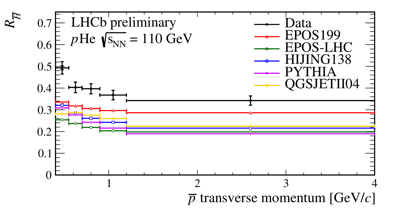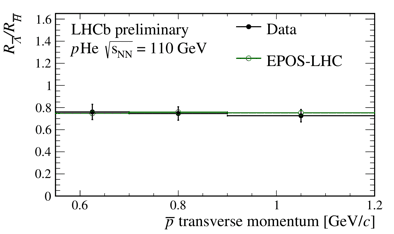Today, at the Quark Matter conference at Kraków, Poland, the LHCb Collaboration presented results of an analysis which may have significant consequences for the search for “dark matter” in the Universe. These results have been also presented recently at the Rencontres de Moriond QCD at La Thuile, Italy. The measurement is of antiproton production in proton-helium (p-He) collisions. Although the LHC collides protons with protons, the LHCb experiment has the unique ability to inject gas, for example helium, into the interaction region and therefore study processes that would otherwise be inaccessible, such as here the production of antiprotons from p-He interactions. The forward geometry and particle identification capabilities of the LHCb detector are well suited to provide good reconstruction for antiprotons down to the low transverse momentum region where most of the production is expected. This gas-injection system was originally designed to help LHCb to measure the brightness of the accelerator’s beams, but is now being used for dedicated physics measurements.
The result announced today is very important for interpreting searches for dark matter in the Universe. Dark matter is a hypothetical entity of unknown nature whose existence would explain a number of otherwise puzzling astronomical and cosmological observations. The name refers to the fact that it does not interact with electromagnetic radiation (like light). Although dark matter has not been directly observed, its existence and properties are inferred from its gravitational effects such as the motion of visible matter around galactic centres and precise measurements of temperature fluctuations in the cosmic microwave background.
An interesting possibility is that dark matter is composed of some kind of stable elementary particles whose existence is proposed in different extensions of the Standard Model of particle physics. In such a case these dark matter particles could annihilate to ordinary particle/antiparticle pairs and produce cosmic antiprotons. However antiprotons can also be produced in standard processes through collisions of cosmic rays with the interstellar medium, of which helium is a significant component. Therefore a potential signature of dark matter is the observation in space of a higher ratio of antiprotons to protons than would be expected from standard processes. Excitingly, this tendency is hinted at in measurements from the PAMELA and AMS experiments. The largest uncertainty in the calculation of standard processes is associated with the knowledge of the cross-sections, in particular that of p-He collisions. This is where LHCb enters the game.
In 2017, the LHCb collaboration presented results of measurements of the antiproton production directly in p-He collisions or through non-weak decays of excited states – called prompt production by physicists. These results, the first using a helium target, contributed to improving the modelling of the secondary antiproton cosmic flux. Today, LHCb physicists announced results of measurements of another significant ingredient coming from the decay of strange anti-hyperons. The anti-hyperons are produced in the p-He collisions and decay at some distance from the collision point. Therefore these decays are called detached. The dominant process is Λ→ pπ+ responsible for about 70% of detached antiproton production with Λ produced promptly.
The image above shows the measured ratio of detached to prompt antiprotons, RH, produced in p-He collisions, as a function of antiproton transverse momentum. The measurements are compared to predictions from different models of antiproton production. The data indicate that all considered generators significantly underestimate the anti-hyperon contribution to antiproton production. These results are expected to provide a valuable input to improve the predictions for the secondary antiproton cosmic flux.
The ratio, of detached antiprotons from Λ decays to the prompt antiprotons, RΛ, is also measured by LHCb. The image to the left shows the ratio of ratios, RΛ/RH, compared to the theoretical predictions. As this ratio is predicted more reliably than the detached antiproton rate, the good agreement between the measured and predicted values provides a mutual cross-check for the results of the two complementary measurements performed by LHCb.
Read more in the LHCb Quark Matter presentation, in the Moriond presentation, in the CERN media update in English and French, and also in the forthcoming publication.


